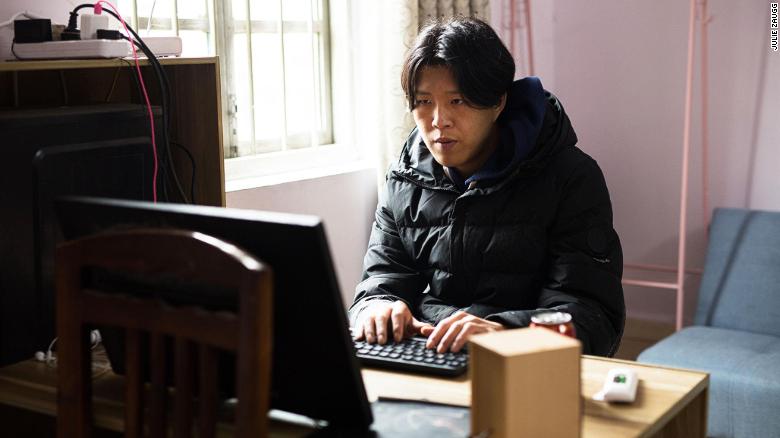How a Pig Farmer Makes $3k a Month
“I don’t want to be in this relationship anymore!”
“Why? Give me another chance!”
“I don’t like your haircut.”
This tense exchange is taking place on a country lane bordered by chili fields in rural Guangxi, a southern province in China.
Wu Nengji, a broad shouldered young man sporting an abundant shock of black hair, is arguing with his ex-girlfriend, an attractive girl wearing tall black boots, and her new boyfriend, whose hair is styled in an improbable bouffant.
It is the opening scene for Wu’s latest mini-movie, lasting less than one minute. The 24-year-old videographer publishes his films on the Chinese streaming platform Kuaishou under the nickname Xiao Jiji, which means “Little Lucky” in mandarin.
“I don’t really have a message to convey,” he says. “I just want to make people smile after a long day at work.”
Once a hobby, Wu makes a living from his videos, earning between 10,000 and 20,000 yuan ($1,475 to $2,950) per month, about three to six times as much as a Chinese factory worker.
All his revenue comes from his fans. They send him virtual gifts — a sticker of a rose or a beer worth 1 or 2 yuan, for example — which he can convert into real money.
His story is far from unique.
“Some streamers barely earn a living and others have become billionaires,” details Jian Xu, a communication specialist from Deakin University, in Australia. “In north-east China, which has been badly hit by industrial decline, whole regions have been revitalized thanks to this new source of revenue.”
Liu Mama, a northern granny whose feisty raps and regional dishes have become cult, is said to earn 1 million yuan ($147,000) per month.
China’s streaming sensation
In China, the streaming of short videos has become a massive industry. The first platforms, YY and Six Rooms, appeared in around 2008. They were soon joined by a host of competitors, such as Meipai, Huajiao, Yizhibo and Douyin. By the end of 2018, 648 million Chinese netizens regularly watched short videos, according to the China Internet Network Information Center (CNNIC). The market for these was worth 11.8 billion yuan (17.4 million dollars), up 106% from the previous year.
Most of these videos have showcased pretty young girls with pale skin and long eyelashes lip-synching to popular songs in studios made up to look like bedrooms.
But in recent years, a few streaming platforms have popped up showing a grittier side of China. They host videos by people living in rural areas or in third and fourth tier cities. Many are based in the rust belt areas of the north east. Kuaishou, which was created in 2011 and has 266 million monthly active users, is one of these.
“Young people living in cities like the videos on Kuaishou because they seem exotic to them, whereas migrant workers watch them out of a sense of nostalgia for the rural life they have had to leave behind,” explains Zhicong Lu, a researcher from Toronto University who has studied the company.
Millions of followers
Wu Nengji started publishing videos on Kuaishou three years ago. He had just returned from Beijing, where he had spent several years working in dead-end jobs. “I tried everything: waiting on tables, delivering food, but I just couldn’t make enough money to live,” he explains. Back in Hepu, the village he grew up in, he didn’t know what to do with himself. So he decided to broadcast his everyday life.
Since then he has produced over 2,000 videos and has amassed 5.6 million followers.
“I use a single smartphone to shoot all my videos,” he says. “I only do one or two takes for each scene.” He uses the small alleys and fields surrounding his father’s pig farm as a setting, embellished with an eclectic mix of accessories: a pink motorcycle helmet, a silver-haired wig and a plastic tiara.
Some of his creations are poetic, showcasing his life on the farm and his troubles finding a girlfriend. Others are absurdist vignettes of him and his friends executing random dance moves to trashy techno music.
Kuaishou is full of peasants plucking rice, fishers trying to catch eels and grannies cooking traditional recipes. “Some farmers use these videos to promote and sell their produce directly to customers,” says Jun Wen Woo, a video streaming expert for IHS Markit, an intelligence firm with expertise on China.
But it also has its own colorful universe.
Kuaishou is where social shake, a collective street dance, was born. It is also the home of mic-shouting, a strange art form somewhere between a rap and rant. And it is full of unconventional characters who appeal to viewers’ more voyeuristic instincts, such as a trio of sisters with brittle bone disease, a couple with dwarfism or a young girl who swallows live goldfish.
Some content also rubs up against state censorship.
During the winter of 2017, when the Beijing authorities started clearing out migrant workers living in tenement style housing, Kuaishou was the only platform to document the evictions.
This didn’t last long.
In 2018, the site was asked to remove any videos deemed “immoral,” including a popular series about teen moms. Gone were the tattoos, swear words and sexual innuendo.
“Kuaishou had to hire hundreds of in-house censors to monitor all of its content,” adds Zhicong Lu. But while tattoos and curse words have disappeared from the platform, Chinese netizens are quite crafty at finding ways to avoid censorship.
Shooting a video
It’s mid-afternoon and a small group of twenty-somethings has started to congregate in front of Wu’s farm. Some have their own streaming channel and are hoping to film a few scenes, others have just come to help out as extras. “Most of them are childhood friends,” says the videographer.
Wearing black sweatpants, a blue hoodie and plastic slippers, Wu doesn’t look anything like an internet star — but here he’s clearly in charge.
He gets everyone to shuffle into a dusty shed where they start debating ideas for the next scene of his video. Everyone pitches in with a comment, a joke or a criticism. The air is thick with cigarette smoke and laughter.
“We often find a concept for the first five seconds of the video and immediately shoot it,” he explains. “We only sit down to discuss the overall concept afterwards.”
They settle on an idea: since Wu’s girlfriend doesn’t like his haircut, he will change it.
Two of his friends grab a can of hairspray and start creating an intricate bouffant on the top of his head. The rest of the video shows him rejecting his enamored ex-girlfriend’s pleas and parading around the farm with two friends.
In three months, the video was viewed 7.7 million times, had 291,000 likes and generated over 15,000 comments.
“At first, my parents were very critical,” says Wu. They wanted me to get a job in a factory and send money back home. But when they saw how much I enjoyed making videos and that I could make a living from this, they changed their minds.”
The sun is about to set. It is time for Wu Nengji, the pig farmer, to feed the pigs. He picks up a can of feed, mixes it with water and starts pouring it with a ladle into the trough to feed the pigs. He picks up a can of feed, mixes it with water and starts pouring it with a ladle into the trough. A bit later, he will sit down in front of his aged computer, which is covered in dust with a keyboard missing several keys, and edit his video.
– CNN







